Lipeng Ma
Multi-modal Multi-task Pre-training for Improved Point Cloud Understanding
Jul 23, 2025Abstract:Recent advances in multi-modal pre-training methods have shown promising effectiveness in learning 3D representations by aligning multi-modal features between 3D shapes and their corresponding 2D counterparts. However, existing multi-modal pre-training frameworks primarily rely on a single pre-training task to gather multi-modal data in 3D applications. This limitation prevents the models from obtaining the abundant information provided by other relevant tasks, which can hinder their performance in downstream tasks, particularly in complex and diverse domains. In order to tackle this issue, we propose MMPT, a Multi-modal Multi-task Pre-training framework designed to enhance point cloud understanding. Specifically, three pre-training tasks are devised: (i) Token-level reconstruction (TLR) aims to recover masked point tokens, endowing the model with representative learning abilities. (ii) Point-level reconstruction (PLR) is integrated to predict the masked point positions directly, and the reconstructed point cloud can be considered as a transformed point cloud used in the subsequent task. (iii) Multi-modal contrastive learning (MCL) combines feature correspondences within and across modalities, thus assembling a rich learning signal from both 3D point cloud and 2D image modalities in a self-supervised manner. Moreover, this framework operates without requiring any 3D annotations, making it scalable for use with large datasets. The trained encoder can be effectively transferred to various downstream tasks. To demonstrate its effectiveness, we evaluated its performance compared to state-of-the-art methods in various discriminant and generative applications under widely-used benchmarks.
AdaptiveLog: An Adaptive Log Analysis Framework with the Collaboration of Large and Small Language Model
Jan 19, 2025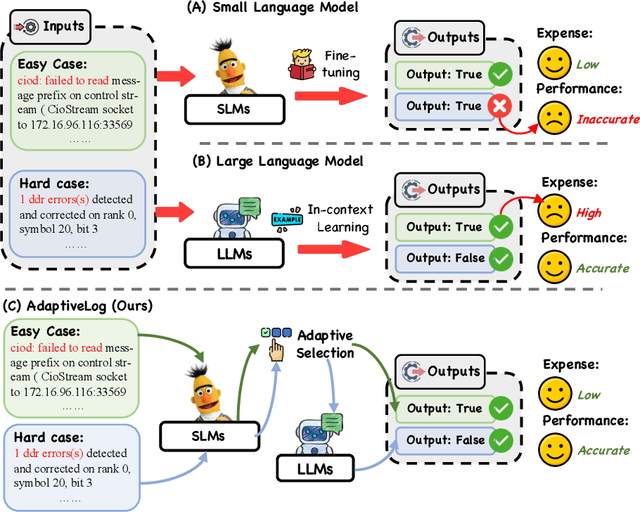

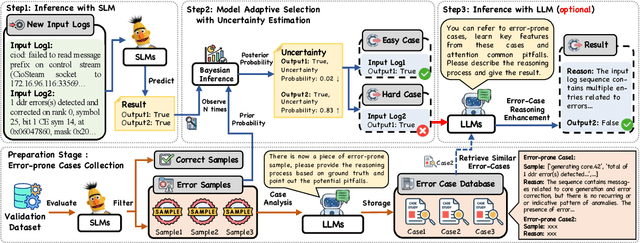

Abstract:Automated log analysis is crucial to ensure high availability and reliability of complex systems. The advent of LLMs in NLP has ushered in a new era of language model-driven automated log analysis, garnering significant interest. Within this field, two primary paradigms based on language models for log analysis have become prominent. Small Language Models (SLMs) follow the pre-train and fine-tune paradigm, focusing on the specific log analysis task through fine-tuning on supervised datasets. On the other hand, LLMs following the in-context learning paradigm, analyze logs by providing a few examples in prompt contexts without updating parameters. Despite their respective strengths, we notice that SLMs are more cost-effective but less powerful, whereas LLMs with large parameters are highly powerful but expensive and inefficient. To trade-off between the performance and inference costs of both models in automated log analysis, this paper introduces an adaptive log analysis framework known as AdaptiveLog, which effectively reduces the costs associated with LLM while ensuring superior results. This framework collaborates an LLM and a small language model, strategically allocating the LLM to tackle complex logs while delegating simpler logs to the SLM. Specifically, to efficiently query the LLM, we propose an adaptive selection strategy based on the uncertainty estimation of the SLM, where the LLM is invoked only when the SLM is uncertain. In addition, to enhance the reasoning ability of the LLM in log analysis tasks, we propose a novel prompt strategy by retrieving similar error-prone cases as the reference, enabling the model to leverage past error experiences and learn solutions from these cases. Extensive experiments demonstrate that AdaptiveLog achieves state-of-the-art results across different tasks, elevating the overall accuracy of log analysis while maintaining cost efficiency.
IceDiff: High Resolution and High-Quality Sea Ice Forecasting with Generative Diffusion Prior
Oct 10, 2024Abstract:Variation of Arctic sea ice has significant impacts on polar ecosystems, transporting routes, coastal communities, and global climate. Tracing the change of sea ice at a finer scale is paramount for both operational applications and scientific studies. Recent pan-Arctic sea ice forecasting methods that leverage advances in artificial intelligence has made promising progress over numerical models. However, forecasting sea ice at higher resolutions is still under-explored. To bridge the gap, we propose a two-staged deep learning framework, IceDiff, to forecast sea ice concentration at finer scales. IceDiff first leverages an independently trained vision transformer to generate coarse yet superior forecasting over previous methods at a regular 25km x 25km grid. This high-quality sea ice forecasting can be utilized as reliable guidance for the next stage. Subsequently, an unconditional diffusion model pre-trained on sea ice concentration maps is utilized for sampling down-scaled sea ice forecasting via a zero-shot guided sampling strategy and a patch-based method. For the first time, IceDiff demonstrates sea ice forecasting with the 6.25km x 6.25km resolution. IceDiff extends the boundary of existing sea ice forecasting models and more importantly, its capability to generate high-resolution sea ice concentration data is vital for pragmatic usages and research.
LUK: Empowering Log Understanding with Expert Knowledge from Large Language Models
Sep 03, 2024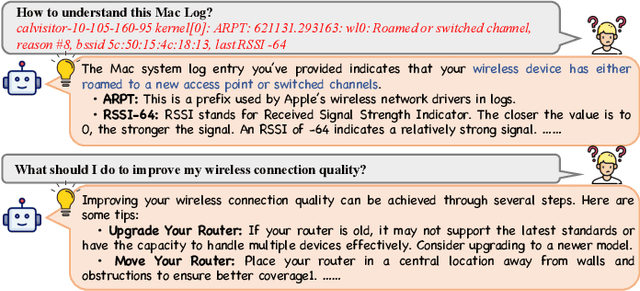
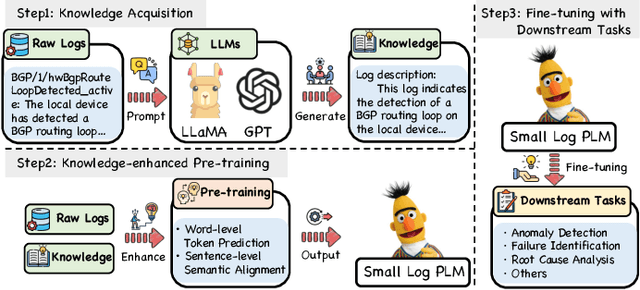
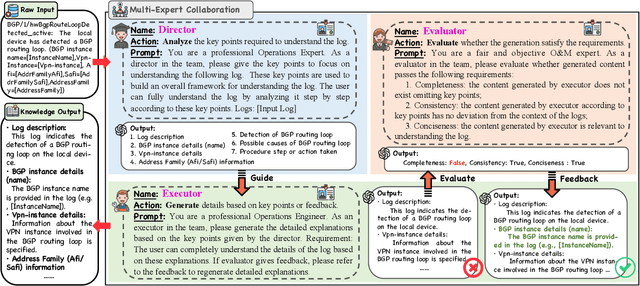

Abstract:Logs play a critical role in providing essential information for system monitoring and troubleshooting. Recently, with the success of pre-trained language models (PLMs) and large language models (LLMs) in natural language processing (NLP), smaller PLMs (such as BERT) and LLMs (like ChatGPT) have become the current mainstream approaches for log analysis. While LLMs possess rich knowledge, their high computational costs and unstable performance make LLMs impractical for analyzing logs directly. In contrast, smaller PLMs can be fine-tuned for specific tasks even with limited computational resources, making them more practical. However, these smaller PLMs face challenges in understanding logs comprehensively due to their limited expert knowledge. To better utilize the knowledge embedded within LLMs for log understanding, this paper introduces a novel knowledge enhancement framework, called LUK, which acquires expert knowledge from LLMs to empower log understanding on a smaller PLM. Specifically, we design a multi-expert collaboration framework based on LLMs consisting of different roles to acquire expert knowledge. In addition, we propose two novel pre-training tasks to enhance the log pre-training with expert knowledge. LUK achieves state-of-the-art results on different log analysis tasks and extensive experiments demonstrate expert knowledge from LLMs can be utilized more effectively to understand logs.
Comprehensive Review of Deep Learning-Based 3D Point Cloud Completion Processing and Analysis
Mar 09, 2022



Abstract:Point cloud completion is a generation and estimation issue derived from the partial point clouds, which plays a vital role in the applications in 3D computer vision. The progress of deep learning (DL) has impressively improved the capability and robustness of point cloud completion. However, the quality of completed point clouds is still needed to be further enhanced to meet the practical utilization. Therefore, this work aims to conduct a comprehensive survey on various methods, including point-based, convolution-based, graph-based, and generative model-based approaches, etc. And this survey summarizes the comparisons among these methods to provoke further research insights. Besides, this review sums up the commonly used datasets and illustrates the applications of point cloud completion. Eventually, we also discussed possible research trends in this promptly expanding field.
 Add to Chrome
Add to Chrome Add to Firefox
Add to Firefox Add to Edge
Add to Edge